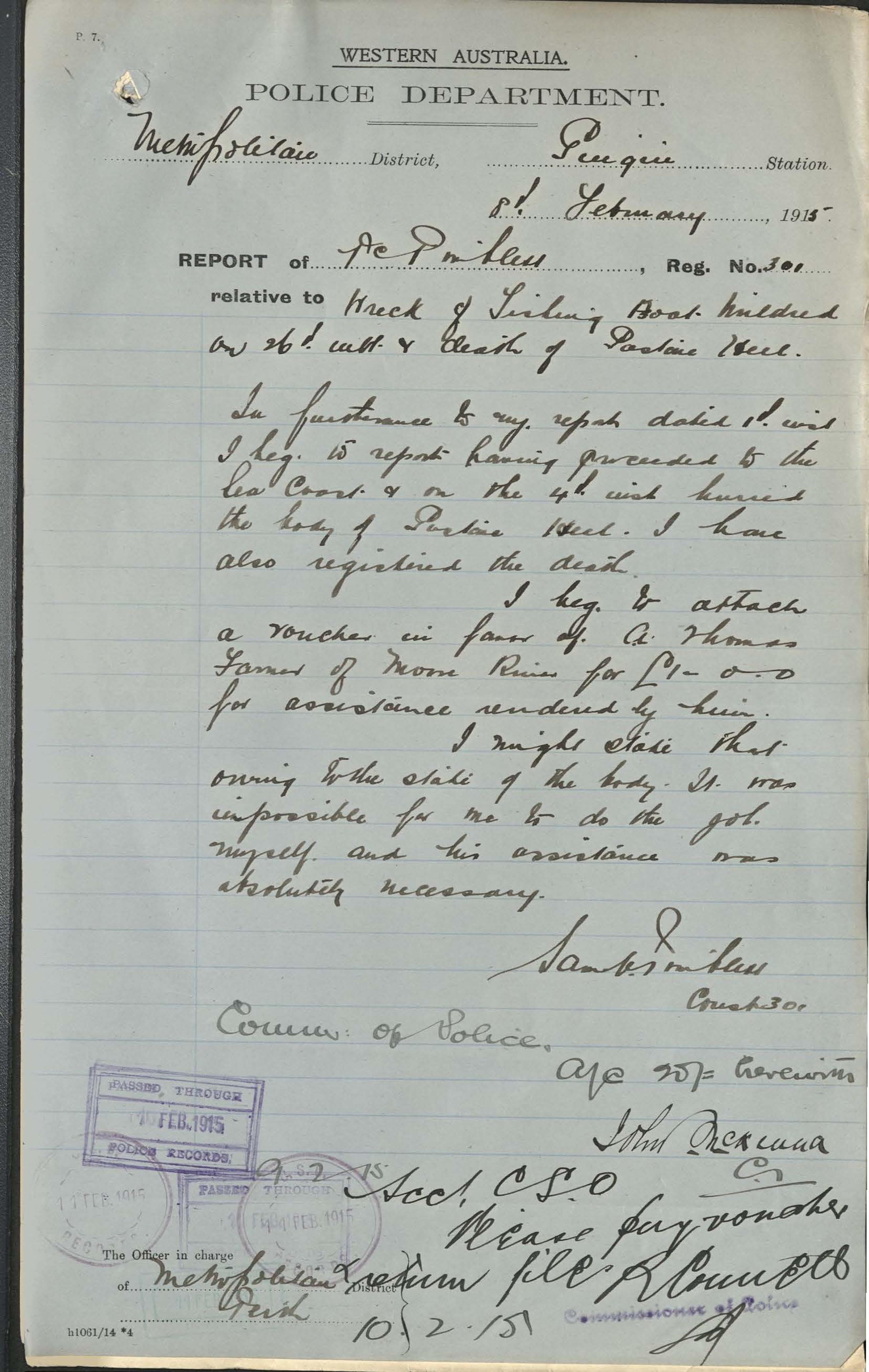Mildred
Vessel Name: Mildred
Gustave Heel/Hill
Drowned at sea;
Body recovered and buried in Lancelin Sand Dunes
26 January 1915

The tragedy was captured in a Police report
The fishing boat, Mildred, owned by Black Brothers Fishmongers of Perth Markets, left Fremantle at 9am on Tuesday, 26 January 1915, for a fishing trip up the coast.
Onboard that day were:
- Gustave (Gus) Heel (also referred to as Hill), born circa 1870 in Newstart, Finland and Captain of the Mildred, single
- Chris Hanson, a Dane
- Jack Froyle, a Russian
Heel was well known, and very popular in shipping circles and his two crewmen, Hanson and Froyle, were also well known in local fishing circles.
In October 1913, Heel was arrested for disorderly conduct and resisting arrest. Somewhat under the influence of drink, he offered to fight anyone that dared, and when asked to go away by Constable Taylor, he refused. From there, things escalated and Heel ended up being arrested. He was charged with disorderly conduct and resisting arrest.
In a previous incident at the National Hotel in July 1913, he was arrested and when facing court the next morning pleaded no recollection of the night before. He enjoyed a drink and appeared before the courts in at least seven minor charges, but was deemed to be ‘a hard-working man and never gave much trouble’.
The three-ton Mildred, was launched some four years before, and was considered a tidy little craft and perfectly seaworthy. All went well until the Mildred was about 10 miles south of Lancelin Island, when around 7pm a gale sprung up and the boat capsized and sank in a matter of five minutes.
From a statement given by Hanson and Froyle, the ice chest floated and the three men clung on to it for three to four hours. They were about two miles from shore, when a strong wave hit them and they were all thrown from the ice chest, which then became partly submerged, and they could not regain their hold.
Heel was struggling in the waves. He had earlier told Hansen and Froyle that he could not swim, so Froyle sang out to him to come this way. Heel cried out that he was done for, and for him to save himself. Hansen started swimming for shore and Froyle got hold of the door of the ice chest, which had become detached, and also headed for the shore.
On reaching shore early on Wednesday morning, they both searched the beach for any trace of Heel, but there was none. In sea-soaked clothes, they walked along the shore and arrived at the Gingin Police Station around 1pm on Thursday, 28 January and reported the incident to Police Constable Plimblett. He then relayed the message through to Perth Central advising them that he would issue the survivors with tickets for the evening train to Perth, and then leave for the scene of the drowning with the intention of picking up the boat and body should they be washed ashore.
Statements were taken from the survivors and recorded in the report of P.C. Plimblett.
P.C. Plimblett left the Gingin Police Station at 11pm on Thursday, 28 January to make a search of the coast. On 30 January, near Edward Island on the north side of the reefs, he plainly saw the ice chest, which was referred to in his previous report, details of which were given by Hanson and Froyle when reporting the accident.
It was about a quarter of a mile from shore from what he could ascertain. Further north, he found some tins and boxes which were no doubt from the boat, also a compass box, four miles north of Edward Island.
He also found the body of Heel washed up on the shore. The body still had both socks and elastic sided boots on, a singlet and striped shirt was covering the head and a leather strap was around the waist. The body was laying on its belly and face with both arms extended, feet pointing shoreward and head to the sea. He could see that it was becoming very decomposed having been exposed to extreme heat over the past few days.
Examining the body, he could see no signs of external injuries or wounds, and from the general appearance of the body he had very little doubt that the cause of death was drowning. With no other option, he dragged the body into the sand hills and placed bags over it with about one foot of sand on top.
The death was reported to the Coroner and after an interview with Hanson and Froyle and reading the report tended by P.C. Plimbett, an order for burial was issued.
Enquiries were made, and there were no relatives of Heel identified that could pay the costs of bringing the body back to Gingin for burial. Given the body was laying about 55 miles from Gingin over very rough terrain and would take around five days to get the body to Gingin, at a cost of about £12.00, an order was made that the body be buried where it is now, with the spot to be carefully marked for identification purposes, if required in the future.
P.C. Plimbett buried the body of Gustave Heel on 4 February 1915, assisted by a farmer from Moore River, A. Thomas, who was paid the sum of £1.00 for his services.
P.C. Plimbett stated in his request for payment to Thomas that owing to the state of the body, it was impossible for him to do the job himself and the assistance of Thomas was absolutely necessary.
A newspaper article of the day read:
‘The well-known Fremantle fishing boat, Mildred, has been added to the ‘shadow ships at sea’ and her gallant Captain, Gustave Heel, has gone where gallant captains go when their careers on mundane waters are finished’.
